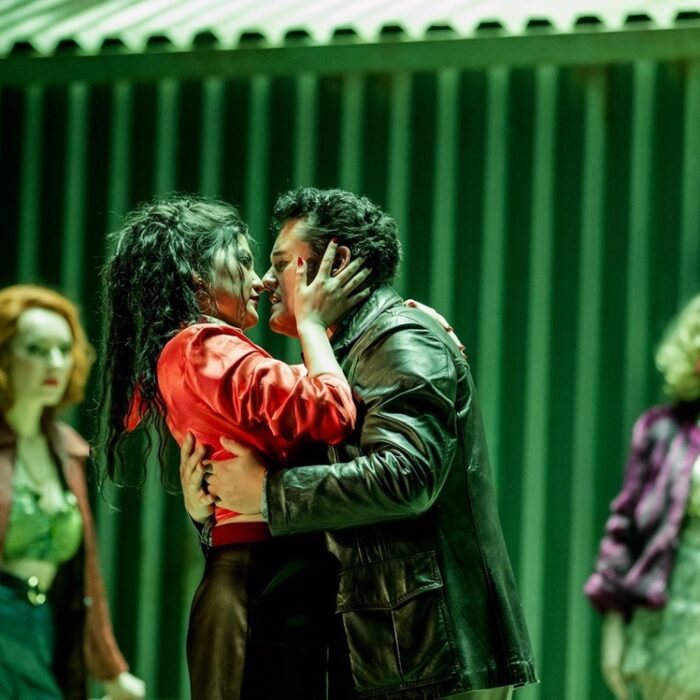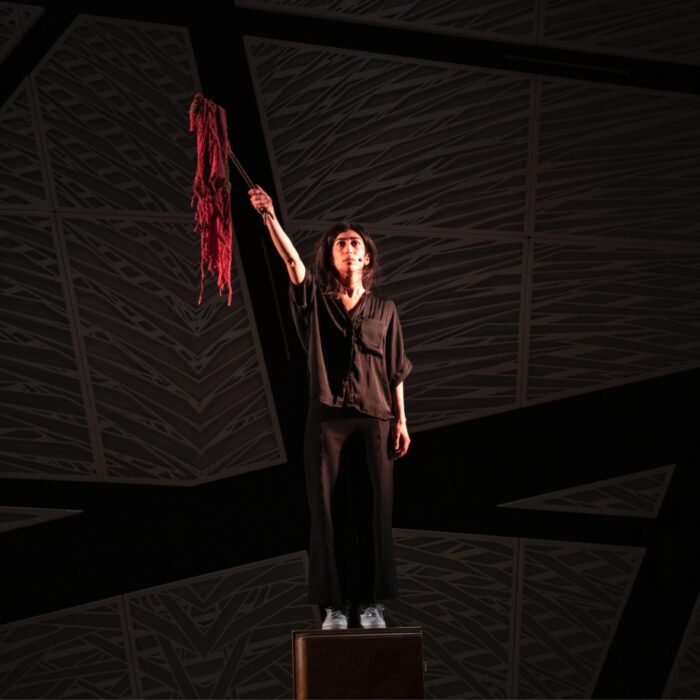
Sofia Opera & Ballet 2023 Review: Die Walküre
Gergana Rusekova, Tsvetana Bandalovska, Thomas Hall Lead Splendid Cast in Solid Production
By Alan NeilsonPhoto: Sofia Opera & Ballet
Having successfully established its aesthetic and dramatic foundations during its production of “Das Rheingold” on the previous evening, Sofia Opera continued with its new presentation of Wagner’s Ring Cycle for what turned out to be a musically and theatrically strong performance of “Die Walküre.”
Kartaloff’s Visually Stunning Direction
The director, Plamen Kartaloff, along with his production team, created a staging that was in many ways fairly basic, centered on three ring-like circular platforms that represented the “spiral of life.” They were moved about the stage, raised, lowered, tilted, and added to with other geometric shapes, to create a series of balanced tableaux. Often the balance was asymmetrical, but occasionally the imaginative positioning of the cast gave the stage a pleasing symmetry.
In the first act, for example, in which a large triangular structure was used as the focal point, Siegfried, Sieglinde and Hunding were occasionally situated to reflect the points of the triangle, creating a splendid image that was magnified by Andrej Hajdinjak’s wonderfully warm lighting. In fact, Kartaloff and his scenographer, Hans Kudlich, completely rejected the use of realistic scenery and used barely any props, so that Hunding’s house amounted to no more than the geometric shapes, and apart from the obligatory sword, stuck into the side wall of the triangle, there was nothing to suggest this was a dwelling or that it had any significance. Yet, it worked well! The coloring and the simplicity of the staging perfectly complemented the largely restrained physical movements of the characters to produce a clear, streamlined reading that promoted the narrative and enabled the characters to develop. There was nothing extraneous to distract or deflect the attention.
It could be argued that the staging was too static and that it compromised the development of the relationships between the characters, but this was not the case. On the contrary, by keeping movement to a minimum, the focus always fell on the singer who was given the space and attention to develop their relationships through the voice. Of course, this did not mean that there was not any movement at all, only that it was allied specifically to the text, and there were rarely any physical histrionics, so that when they did occur, they were all the more powerful for the fact.
Kartaloff’s only noticeable additions were the introduction of characters who were being invoked as memories. For example, when Wotan recounts how he has managed to entrap himself in “Als junger Liebe Lust mir verblich,” Wotan, Loge and Alberich appear within one of the raised circles at the back of the stage. It was a device he also used in the other operas from the cycle, and it worked well in connecting the threads that link them.
On this occasion, Hristiyana Mihaleva-Zorbalieva’s costumes were consistently appropriate. It was the Valkyries, however, that stood out, looking resplendent in their red and silver battle dresses, which included a hint of their Norse background. Fortunately, there was no suggestion of American comic book hero-type designs, which had, probably unintentionally, defined a couple of the characters in “Das Rheingold.”
The highpoint of the staging, or maybe it was the low point, depending on how one viewed it, was the opening to Act three. The eight Valkyries arrived on stage on life-sized, bright red horses. These were not passive horses, however, but galloping, rearing horses that were constantly on the move. The problem was that they were being pushed around on trolleys, and although attempts were made to block out the men doing the pushing, it was almost impossible and compromised the theatrical illusion, but if and when one could ignore them, it was indeed spectacular!
As with “Das Rheingold,” the overriding impression of the staging was the wonderful tableaux that the production team were able to create. Almost every scene was aesthetically strong and, at times, even stunning. This was best exemplified in the final scene in which Brünnhilde was laid to sleep in the centre of one of the ring-like circles, onto which Ivan Lipchev’s video imaging of an encircling fire was projected, with support from Hajdinjak’s red and yellow lighting against a black background. This helped ensure that the evening was brought to a breathtaking conclusion.
A Performance Memorable for Its Strong Singing
With one exception, the cast all produced strong performances. Unfortunately, bass Angel Hrsitov, playing the role of Hunding, found himself in an uncomfortable place. Towards the end of Act one, scene two, his voice cracked and was unable to recover, forcing him to struggle on bravely to the end. Yet, he had started well. His voice was forceful, his phrasing deliberate, and his intonation had a threatening curl that gave him a suitably vicious demeanor.
Of the three singers employed for the role of Wotan, baritone Thomas Hall, playing the “Die Walküre” Wotan, proved to be the most accomplished. Exuding an authoritative, confident manner with a strong stage presence, he had the necessary gravitas to bring Wotan to life. Even when he is berated by Fricka into allowing Siegmund to be killed or succumbing to his decision to abandon his beloved Brünnhilde, he always maintained a dignified air. He was a regal god. Likewise, his singing was also high quality. His vocal line was expertly moulded using emotionally charged inflections and dynamic contrasts to capture his conflicting feelings. His voice possessed body, was strong across the range, and had the necessary resonance to dominate the orchestra, even in its louder sections.
Soprano Mariana Zvetkova as Fricka, whom she also played in “Das Rheingold” on the previous evening, responded positively to Hall’s more forceful Wotan. Upping her performance, she attacked the role head-on with an energetic, emotionally aggressive display that brilliantly captured her character’s rage and anxieties. Yet it was also a well-controlled performance. Both angry and raging she may well have been. But, she always held and developed the vocal line with a high degree of precision, while her forays into her upper register were strong and secure.
In the role of Siegmund was tenor Martin Iliev. His voice has a pleasing tone with a fine degree of versatility, strength and consistency, which he used to good effect. He was sensitive to the dramatic and emotional drivers that shape his character and successfully brought out his passionate nature in his exchanges with Sieglinde, Hunding and Brünnhilde. He made full use of his ability to voice his highly charged emotions.
Soprano Tsvetana Bandalovska made an excellent impression with an equally passionate performance as Siegmund’s sister and lover, Sieglinde. She possesses a very attractive voice that quickly drew in the listeners and captured their sympathy, which she supported with her expressive phrasing. She was able to move her voice with ease. At end of Act one, the lovers come together for a concluding duet, which they rendered with both passion and sensitivity while generating sufficient tension to hold the attention. Its success can be measured by the fact that they completely won over the audience, despite their incestuous and adulterous relationship.
Mezzo-soprano Gergana Rusekova, playing the role of Brünnhilde, burst onto the stage at the beginning of Act two with her bright, clear voice pounding out her signature call, “Hojotojo.” This set a standard from which she never wavered. Underpinned by her pleasing timbre, her singing was resonant, energetic and secure. This enabled her to successfully develop a convincing portrait of the Valkyrie. Her acting, however, was possibly a little understated, even by the standards of Kartaloff’s approach. Her love for her father, Wotan, however, was never in doubt, even when she was disobeying him. The rapport she was able to develop with Hall provided some of the most satisfying musical episodes of the evening. Both of their voices possessing the necessary presence and technique to carry the scenes in which they appeared. The final scene, in particular, was brilliantly and sensitively constructed so that the subtle transition in their emotions from opposition to complete understanding flowed seamlessly with a heart-rending heaviness that transfixed the audience.
The eight Valkeries, played by sopranos Ayla Dobreva, Silvia Teneva, Lyubov Metodiev, Ina Kalinova and mezzo-sopranos Elena Mekhandzhiyska, Tsveta Sarambelieva, Alexandrina Stoyanova and Vesela Yaneva, made a splendid impression riding around on their bright red horses. The energy with which they engaged with the scene was matched by the energy from the orchestra and from their singing. It was full of excitement and vitality.
There were a number of minor problems with the orchestra in “Das Rheingold,” which Constantin Trinks, conducting the Orchestra of the Sofia Opera and Ballet, managed successfully to correct. There were, however, no such problems with “Die Walküre.” The orchestra hit the ground running and created a dramatically powerful and vibrant reading that responded to the twists and turns of the events unfolding onstage. Despite the understrength orchestra, which unavoidably compromised the lush sound of the strings and certain textural qualities, Trinks engineered a convincing reading that emphasized the dynamic contrasts. This built thrilling crescendi and never lost sight of the overarching musical shape. The attention he lavished on singers allowed for a pleasing balance between the pit and the stage, so that the singers could always be clearly heard.
Overall, this was an excellent performance. In all respects, it hit the mark. It was visually excellent, although possibly some members of the audience would have preferred a more animated production with more physical movement and props. The singers, despite Hristov’s mishap, were in good form, and the orchestra held the attention throughout with an energetic yet sensitively aware performance. And perhaps most importantly, the narrative was successfully and imaginatively brought to life.



